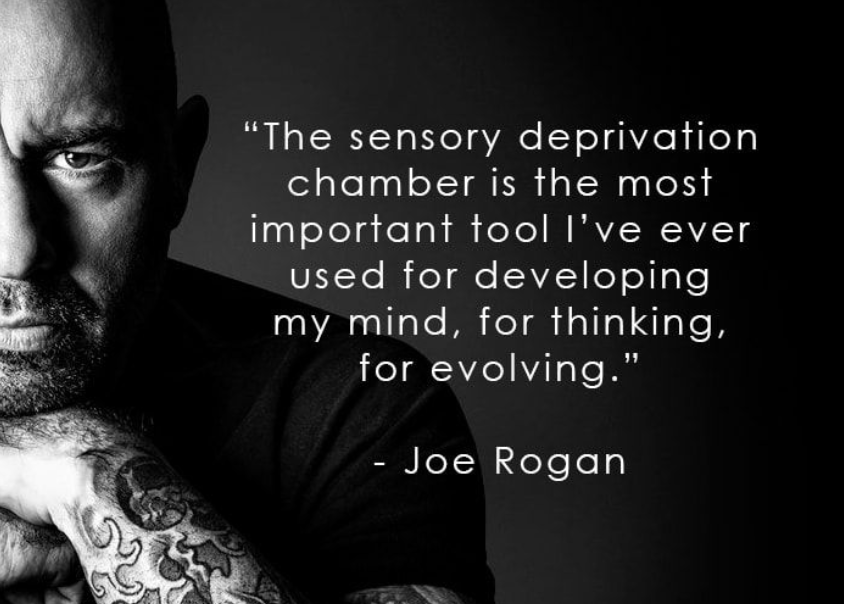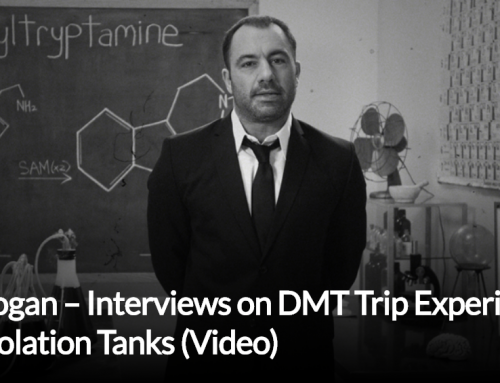We love Joe Rogan here at Serene Dreams. Besides his day job as a comedian, actor and UFC commentator, the New Jersey-born martial artist has done more than any other celebrity to popularize floatation therapy. When they come in, we always ask our new floaters how they heard about floatation therapy, and often the response is “Joe Rogan.”
But what does the former host of NBC’s Fear Factor have to say about floating exactly? Check out one of his awesome podcasts (from The Joe Rogan Experience) set to video.
Video Transcript
The sensory deprivation chamber has been the most important tool that I’ve ever used for developing my mind, for thinking, for evolving.
The tank is filled with water. The water is heated to the same temperature as your body. And there’s 800 pounds of salt in the water, so you just float there and relax. And because the water is the temperature of your body, you don’t really feel it after awhile.
It’s like layers of an onion. When you first start doing the isolation tank, you can only get a couple of the layers of the onion in, a couple skins loose. You can’t really go to the core. It’s too hard. It’s too large to completely let go who you are. But as you get better at it, and as you get more and more comfortable with the experience, you get better at actually letting go—really letting go, letting go from letting go, letting go from the feeling of letting go, letting go from THAT point. “Okay I’ve let go now. No, you haven’t let go more.” And then you become “gone.” You disappear, and while you’re disappearing, this is what happens. You start thinking, “I can’t believe I’m disappearing,” and then you’re back again. You got to start from square one.
You got to let go and you got to let go and you got to let go and get to the point where you literally completely relax, and your body, it gives you amazing energy. Your body, the tension release that you have in your body from a couple hours in the tank is incredible. You feel lighter. You feel like more oxygen is in your body. You feel like more vibrant. And it’s just because you have somehow or another, you know, calmed the tension. It’s incredible, man.
The first 20 minutes or so, for me at least, it’s like sort of a seminar on my life. It shows me all the different issues in my life that I don’t like and that I need to fix, and things that are bothering me, and things about my own behavior that could have been better, and things where I’ve disappointed myself. And then it’ll show me some things where I am on the right track: this is good, continue here, continue doing this, continue thinking like this, continue exploring these ideas. But then, once it gets me done, it’s like, let’s clear out all this bull in your life then let’s think about the big picture. And then it goes from that, to like the sort of relaxing position where my whole body is just settled into the experience. And then it’s like, it’s just pure thought. It’s like the mind completely untethered from the body. And then I start contemplating everything. I start contemplating the universe, contemplating the role of human beings in each individual’s actions, all accumulated together into one specific event. I start thinking all kinds of crazy, crazy stuff, but without the body in the way.
You know even us having this cool conversation here—we’re sitting here on a couch, we’re looking at each other, we’re looking at computers and there are sounds and noises and there is a lot of distractions. You know, just your body is a distraction. And you’ve got some crazy environment that doesn’t exist anywhere else in the world, and it’s fairly inexpensive to achieve. If the tank was something where it was a machine and you would have to like strap yourself in and it would take you through a course where you would learn how to get to the center of consciousness where your body and your mind didn’t exist, it would be like a ride in Disney Land and the line would be seven hours long. But because it’s this weird sort of organic method of doing it, it seems strange, like you are going to get in this big coffin filled with water and you close the lid.
And people start coming up with reasons why they don’t want to do it. It’s so important. Everybody should do the tank. You will learn more about yourself than any other way. And if you have an aversion to drugs—which totally makes sense if you think that drugs are dangerous, that you can get addicted to things, that’s true, you can—if you don’t trust yourself, if you don’t like the idea, you can have very introspective psychedelic experiences naturally in the tank. Everybody should be doing it. It’s an amazing way to think.
When I have a concept or something that I am working on, two things I will do. One, I’ll sit down, I’ll flush it out or write what I think about things just off the top of my head. And then, once I’ve done that, once I’ve really kind of explored, then I get in the tank and I rethink the whole thing. And then when I rethink the whole thing, sometimes in the tank I consider other places, or other points of view. I consider other ways of looking at it where I may not have been sensitive to another person’s opinion coming from another position. And I look at the whole thing almost outside of myself.
There is so much thinking that goes on in that tank. There is so much evolution that goes on in there. It seems like it’s almost impossible to do outside of it, because there’s no distractions in there, nothing at all. It’s just a thought. It’s an amazing environment. It really should be taught in schools. All universities should have them. They should have them and they should make them available to all of their students. One of the greatest tools ever for exploring, thinking, exploring the way you think, and sort of making an audit of all your own personal thoughts and ideas—which ones you’re hanging onto because of your ego, which ones you’re hanging onto because they are beneficial to you, which ones you’re hanging onto because you hate your dad and you know he put these in your head. And so they’re stuck in there. And it’s so fascinating, man, and so few people do it.
Visit Salt Float Studio in South Perth for your opportunity to experience floatation therapy as described by Joe Rogan in our state-of-the-art sensory deprivation chambers. Rest, relax, de-stress and dis-connect from all outside and external stimuli to reach a greater, more in-depth version of YOU. Salt Float Studio is located at 2/129 Canning Hwy, South Perth and is open 7 days a week from 9am until late! For more information you can phone our new studio reception on (08) 6277 0060 or email us at info@saltfloatstudio.com.au




